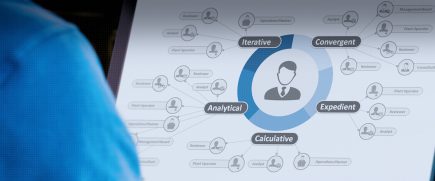Businesses, governments, educational and social institutions alike are asking some common big questions today. How can we navigate the disruptive forces of technology and globalism and create viable solutions which allow us to respond to rapid change? How can these solutions cater to the development of both individuals and societies in general?
Hari Nallan & Mohita Jaiswal - June 2019

These questions are imploring us to rediscover innovative ways to solve problems which are both complex and interdisciplinary(for eg. what can we do to make healthcare personalized and accessible, anywhere and anytime?). While also highlighting the need to take into consideration how these solutions(for eg. using AR/VR into healthcare) can be made usable for masses, as they find pathways to mainstream adoption.
The next big thing is the one that makes the last big thing usable. – Blake Ross, Co-creator of Mozilla Firefox
Design thinking framework and user-centered design process are both light sources to the end of this tunnel of conundrum, offering an approach to address both these questions.
But how can we utilize these? And when and where to use each?
What is Design Thinking?
John E. Arnold was one of the first authors to use the term ‘Design Thinking’ in “Creative Engineering” (1959) while the term was popularized by Stanford’s d.school- David Kelley, Terry Winograd, and Larry Leifer. Design thinking is an approach to problem-solving which is fundamentally different from traditional approaches of solving problems. Inspired by the mindsets, processes, and approaches taken up by other innovators, it has evolved to create a culture of innovation that not only helps in the development of new products and services for customers but also new strategies and concepts for organizations.
What is UCD?
The term user-centered design was coined in Donald A. Norman’s research laboratory in the University of California, San Diego. The concept became widely popular after the publication of the book “User-Centered System Design: New Perspectives on Human-Computer Interaction” in 1986 and was further popularized by IDEO.org. The goal of UCD is to make something useful for the end user, and all decisions during the entire design process are taken considering the user in mind. It overlays design thinking to ensure that the products/solutions are actually relevant and beneficial. The international standard 13407 is the basis for many UCD methodologies and the process is commonly used in the context of the Software development lifecycle.
What are Principles which both bring on the table?
The perspective of design thinking can be considered as wider than the one of human centered design. Design thinking focuses on innovation and creation and is about a way of thinking for developing new products, services and solutions for social problems. While user-centered design is a methodology which is practiced to improve the usability and user experience of a certain product or service.
Ideas where DT and UCD converge
1. Human-Centric Empathy
One should know and empathize with the user to be out of one’s own biases and assumptions of the problem.
2. Collaborative Multiple Perspectives
Collaboration is encouraged as working in silos often leads people to accept their own intuition and to start designing for themselves
3. Optimistic Reframing Problems into Opportunities
Bias towards Action is necessary to translate thinking into some structure/design. Looking at problems as opportunities facilitate that!
4. Experimental Learning from Mistakes
The convergent and divergent frames of thinking and iteration based on testing are the first steps to start learning. Failures become generative to create relevant solutions!
Where do Design Thinking and UCD part ways?
The point of difference and departure between UCD and DT is also on the difference of their principles of focus. UCD focuses on addressing the whole user experience, hence involving users throughout the design and development is considered primary. While Design thinking focuses on resolving both ill-defined or ‘wicked’ problems primarily, it places greater emphasis on adopting solution-focused strategies and use of abductive reasoning.
How will one go about approaching both Design Thinking and UCD?
Have you ever used tools like personas, contextual inquiry, scenarios to investigate more about your customers? Or have you gone ahead to do usability testing for your products? You might have just stepped in exploring the design thinking way of solving problems or created user-centered solutions.
Comparison: Process of Design Thinking and User Centered Design
Design Thinking
User Centered Design
Empathize/observe
Users/system is understood better by inquiring/observing their thoughts/feelings/behavior/properties.
Identify need
Here one starts by identifying what users pain points and goals are in the context of product/service/problem statement through user research
Define
Based on user/system needs and insights drawn a point of view is established which helps define the problem.
Specify Context of use
Based on who will use the product, the context of the usage is further defined
Ideate
All possible ideas are brainstormed and generated which could address the problem
Specify Requirements
Business requirements or user goals are stated in the context of the commonly shared problem
Prototype
A minimum viable prototype is generated to check for its adoption
Produce design solutions
In partnerships with stakeholders, end-users rough concepts and designs are generated
Test
While testing the prototype, more about the end-user/system is known and helps to reiterate the process to build and implement the most viable and usable solution
Evaluate Designs
Usability testing with actual users is used to gather feedback and validate or re-iterate solution.
Both these approaches go through phases of divergence and convergence in their cycle of iteration to lead one to a solution. Just like the process of creation or creative thinking as shared by Graham Wallace in 1926 through his model for the creative process, one moves from preparation, incubation, illumination to verification. Innovation solving the challenges relevant to your user might just be up your sleeve!
Solving Big Questions: Are you inspired enough?
When you wish to approach problem-solving creatively(for instance why are my employees unable to manage their time?), design thinking can guide you to understand and define what the real problem is through observing and empathizing (also help you to avoid reinventing the wheel). A point of view once generated can be used to ideate solutions and generate prototypes iteratively, where through the means of this one can identify real challenges, visions, and potential solutions.
While when you start on a premise of creating solutions that are usable and relevant for users, (for instance if you wish to ensure that your delivery service is more customer-friendly) human-oriented design UCD can lead you to a concrete user-oriented implementation.




